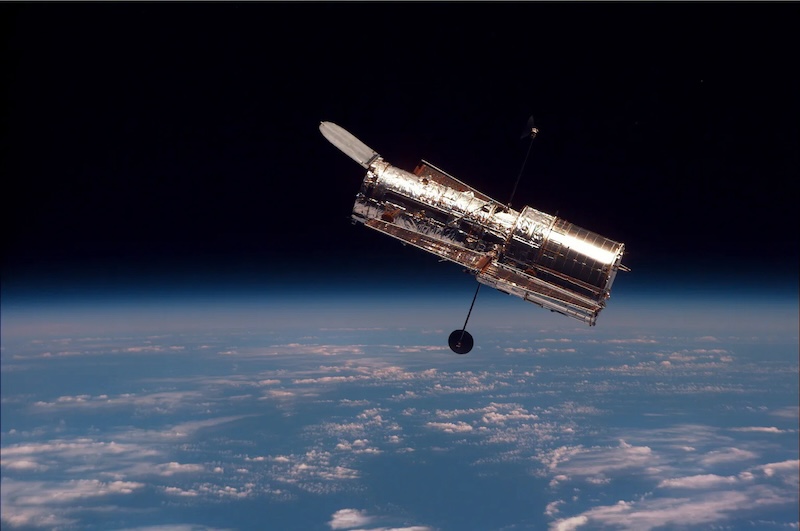- Brown-dwarfs are star-planet hybrid objects, with a mass in between that of stars and planets.
- The older and less massive a brown dwarf is, the less likely it is to have a companion brown dwarf.
- Over time, it appears, the brown dwarf companions just drift apart.
Older brown dwarfs are more likely to be lonely
Most stars come in pairs, or binary systems. Brown dwarfs – objects more massive than Jupiter but less massive than the smallest stars – can come in binary pairs, too. But a new study with the Hubble Space Telescope has found older brown dwarfs are less likely to have companions. On March 21, 2024, an international team of scientists said the older and less massive a brown dwarf is, the more likely it is to wander through space alone. It appears that many binary brown dwarfs drift apart, over timescales of millions of years.
The researchers first published their peer-reviewed paper in the Monthly Notices of the Royal Astronomical Society on September 22, 2023.
Give back to astronomy with a donation to EarthSky.org! Your gift will support educational resources that teach people of all ages about space exploration and the fascinating facts about our universe.
Older and lower-mass brown dwarfs unlikely to have companions
Hubble found that it’s rare for a lower-mass, and cooler, brown dwarf to have a binary companion. The researchers studied a sampling of 33 older and cooler brown dwarfs in our local galactic neighborhood. The team used two different near-infrared filters on Hubble, one in which a cold brown dwarf will appear bright, and another covering specific wavelengths where it will look very faint due to water absorption in its atmosphere.
NASA’s Wide-Field Infrared Survey Explorer (WISE) had previously found these brown dwarfs. Most of them are only a few hundred degrees warmer than Jupiter. None of them had binary companions, even though Hubble can detect binary companions as close as 300 million miles (480 million km) to each other. That’s about the same distance from the sun to the asteroid belt in our solar system.
Astronomers have previously found that younger brown dwarfs often do have companions, however. Lead author Clémence Fontanive of the Trottier Institute for Research on Exoplanets at the University of Montréal, Canada, said:
Our survey confirms that widely separated companions are extremely rare among the lowest-mass and coldest isolated brown dwarfs, even though binary brown dwarfs are observed at younger ages. This suggests that such systems do not survive over time.
What does this mean? It suggests younger brown dwarfs generally aren’t massive enough to have sufficient gravity to keep the pair together. Instead, they gradually drift apart over hundreds of millions of years.
Born the same way as stars
The findings not only provide new information about brown dwarf binaries but how a brown dwarf itself forms and evolves. And the results support previous theories that brown dwarfs form the same way stars do. This involves both of them forming from the gravitational collapse of a cloud of molecular hydrogen. But then why do brown dwarfs end up so different from stars?
Essentially, brown dwarfs are not massive enough for the nuclear fusion of hydrogen to occur.

Similarities to binary stars
More than half the stars in our galaxy have a binary companion. And, similar to brown dwarfs, it’s more massive stars that are typically in those binary systems. That prompted the researchers to compare them to brown dwarf binaries and look for similar trends, as Fontanive noted:
The motivation for the study was really to see how low in mass the trends seen among multiple stars systems hold up.
Our Hubble survey offers direct evidence that these binaries that we observe when they’re young are unlikely to survive to old ages; they’re likely going to get disrupted. When they’re young, they’re part of a molecular cloud, and then as they age the cloud disperses. As that happens, things start moving around and stars pass by each other. Because brown dwarfs are so light, the gravitational hold tying wide binary pairs is very weak, and bypassing stars can easily tear these binaries apart.
The new data from Hubble is the best ever obtained so far regarding brown dwarf pairs. Fontanive said:
This is the best observational evidence to date that brown dwarf pairs drift apart over time. We could not have done this kind of survey and confirmed earlier models without Hubble’s sharp vision and sensitivity.
Bottom line: NASA’s Hubble Space Telescope has found that older and less massive brown dwarfs tend to be alone with no companions, unlike brown dwarfs that are younger and larger.
Source: An HST survey of 33 T8 to Y1 brown dwarfs: NIR photometry and multiplicity of the coldest isolated objects
Via Hubblesite
Read more: What are brown dwarfs?
Read more: 95 new cool brown dwarfs in the sun’s neighborhood